Info
Subfamily: Chloridoideae
Genus etymology: Eragrostis = "love grass" [Greek] unclear origin, other etymologies such as "early grass" or "very grass" have also been speculated
Species etymology: cylindriflora = "cylinder flower" [Latin] refering to the florets round in cross-section
Photosynthetic type: C4 (warm season)
Nativity: naturalized - accidental
First recorded in Hawaiʻi: 1981
Map
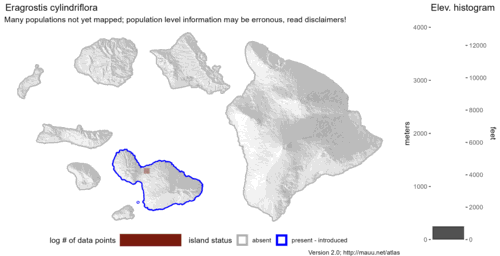
Inflorescence
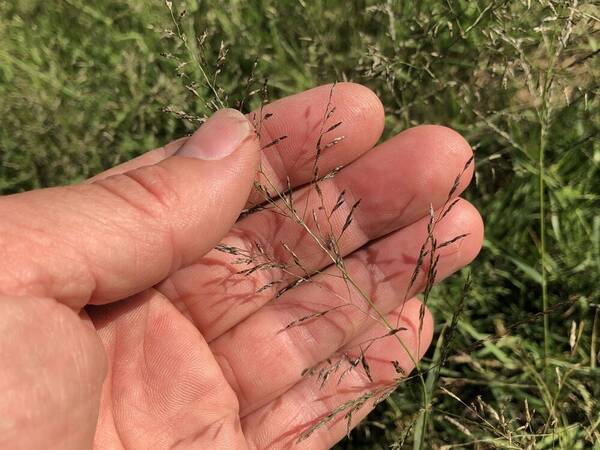 image credit: spookpadda
image credit: spookpadda image credit: David_Hoare
image credit: David_HoarePlant
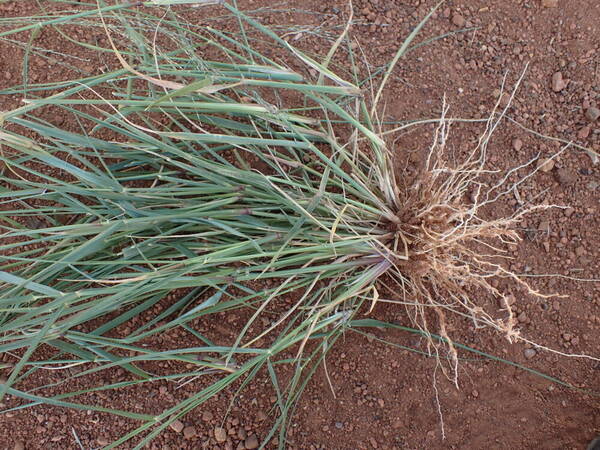 image credit: David_Hoare
image credit: David_Hoare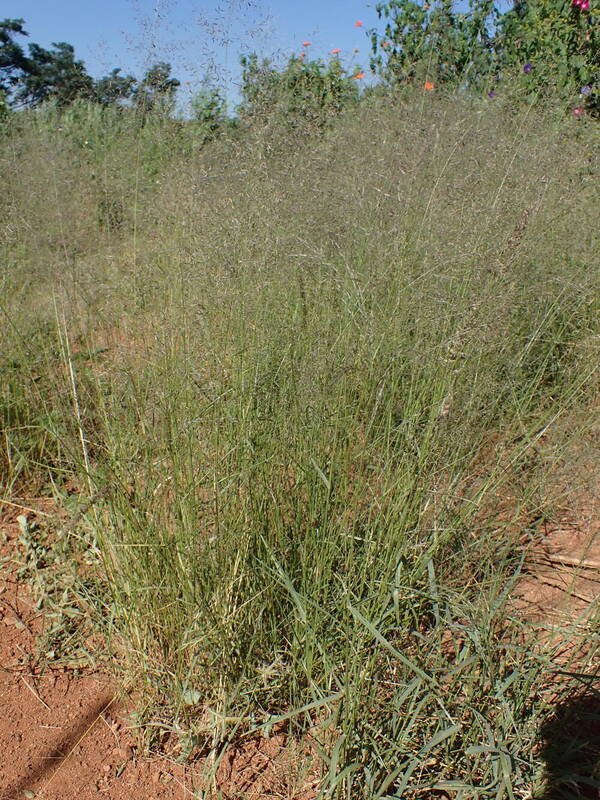 image credit: David_Hoare
image credit: David_HoareSpikelets
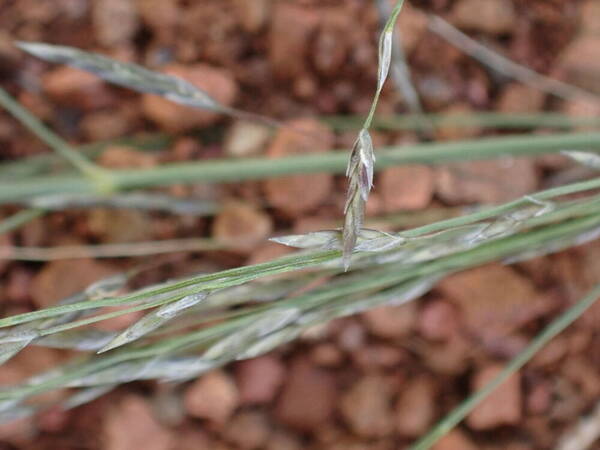 image credit: David_Hoare
image credit: David_HoareCollar
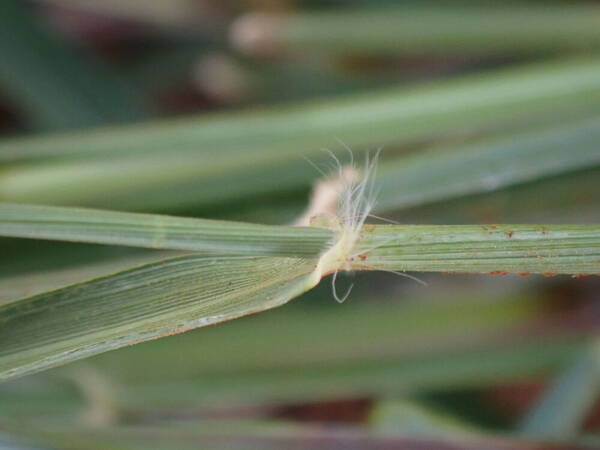 image credit: David_Hoare
image credit: David_HoareDescription
Loosely tufted annual; culms 30–60 cm. high, erect or ascending, usually with a ring of elongated glands just below the node. Leaf-blades flat or rolled, 3–15 cm. long, 2–4 mm. wide; sheaths glabrous, nearly always dotted with oblong crateriform glands (rarely pilose with tubercle-based hairs, these sometimes mixed with glands). Panicle narrowly ovate, 8–25 cm. long, the branches in successive whorls, these glabrous or with a few hairs in the axil, the main axis glabrous or sometimes pilose. Spikelets 4–14-flowered, linear, 3–8 mm. long, 1–1.5 mm. wide, grey-green, commencing to break up from the base, the rhachilla persistent below but fragile above; glumes narrowly ovate, 1.5–2 mm. long, hyaline to membranous, greyish, the lower 4/5 to as long as the lowest lemma; lemmas broadly elliptic, 1.5–1.7 mm. long, with obscure lateral nerves, obtuse to subacute; palea minutely scaberulous on the keels, persistent; anthers 3, 0.8–1 mm. long. Caryopsis ellipsoid, 0.5–0.7 mm. long. Fig. 66.
(Description source: Clayton, W.D. 1970. Flora of Tropical East Africa. Gramineae (Part 1). Crown Agents for Oversea Governments and Administrations, London. 176 pp. )
Caespitose annual, short-lived perennial or tussocky perennial without rhizomes, the leaves mostly cauline; culms up to 80(100) cm tall, erect or ascending, stout or wiry, sometimes rooting from the lower nodes, branched or unbranched, glabrous at the nodes, sometimes pilose on the internodes, usually with a ring of elongated glands below the nodes; leaf sheaths glabrous or rarely pilose with tubercle-based hairs, eglandular or dotted with oblong or circular glandular pits, the basal firmly chartaceous to thinly coriaceous, usually glabrous below, terete or somewhat compressed, inconspicuously ridged; ligule a line of hairs; leaf laminas 3–25 cm × 2–5 mm, linear, flat or involute, glabrous or sparsely pilose with tubercle-based hairs, eglandular.Panicle 8–40 cm long, narrowly ovate to narrowly elliptic, loose and open, the spikelets evenly distributed on pedicels 0.5–2.5 mm long, the primary branches mostly unbranched in the lower 1/4, in a succession of whorls, terminating in a fertile spikelet, sometimes glabrous (especially above) but usually thinly to densely pilose in the axils (especially the lowermost whorl), eglandular.Spikelets 3–8 × (0.8)1–1.5 mm, linear to narrowly elliptic-oblong, lightly laterally compressed, (4)7–14-flowered, the lemmas disarticulating from below upwards, the rhachilla persistent below but fragile above; glumes subequal, thinly membranous, 1.5–2.7 mm long, lightly keeled, lanceolate in profile, scaberulous on the keel, subacute to acute at the apex, the inferior reaching to at least 4/5 the way along the adjacent lemma, sometimes right to or even beyond the apex, the superior to about the middle; lemmas 1.5–2 mm long, lightly keeled, narrowly oblong-elliptic in profile, membranous but with obscure lateral nerves, ± appressed to the rhachilla, those in opposite rows not imbricate, the rhachilla visible between them, grey-green, minutely asperulous, obtuse to subacute at the apex; palea persistent, glabrous on the flanks, the keels slender, wingless, glabrous to scaberulous; anthers 3, 0.7–1 mm long.Caryopsis 0.5–0.8 mm long, elliptic.
(Description source: Pope, G.V. (ed). 1999. Flora Zambesiaca. Volume 10. Part 2. Kew, London. 261 pp. )
Plants perennial; cespitose, stoloniferous, forming innovations near the base. Culms 30-70 cm, erect, geniculate, or prostrate, often rooting at the lower nodes, glabrous, with a ring of glands below the nodes. Sheaths glabrous or with scattered papillose-based hairs over most of the surface, apices pilose, hairs 1-4 mm, a ring of oblong glands sometimes present below the collar; ligules 0.2-0.5 mm; blades 1.4-10 cm long, 2-3 mm wide, flat to involute, sparsely hairy with papillose-based hairs, abaxial surfaces often with glandular dots. Panicles 5-20 cm long, 2-7 cm wide, narrowly ovate, open; primary branches 2-7 cm, diverging 10-70° from the rachises, lowest branches whorled, naked proximally, bases with a glandular band; pulvini hairy; pedicels 0.3-3.3 mm, glandular. Spikelets 4-5.4 mm long, 1-1.5 mm wide, linear-lanceolate, plumbeous to greenish-gray, with 3-5 florets; disarticulation acropetal, paleas persistent. Glumes subequal, 1.4-1.8 mm, ovate-lanceolate, membranous; lemmas 1.5-1.8 mm, ovate, membranous, often hyaline, lateral veins inconspicuous, apices obtuse to acute; paleas 1.3-1.7 mm, hyaline, bases not projecting beyond the lemmas, apices obtuse; anthers 3, 0.7-1 mm, purplish. Caryopses 0.6-0.8 mm, ovoid, terete to dorsally compressed, shallowly grooved adaxially, translucent, mostly whitish to light brown, bases often greenish. 2n = unknown.
(Description source: Barkworth, M.E., Capels, K.M., Long, S. & Piep, M.B. (eds.) 2003. Flora of North America, north of Mexico. Volume 25. Magnoliophyta: Commelinidae (in part): Poaceae, Part 2. Oxford University Press, New York. 783 pp. http://floranorthamerica.org/Eragrostis_trichophora )